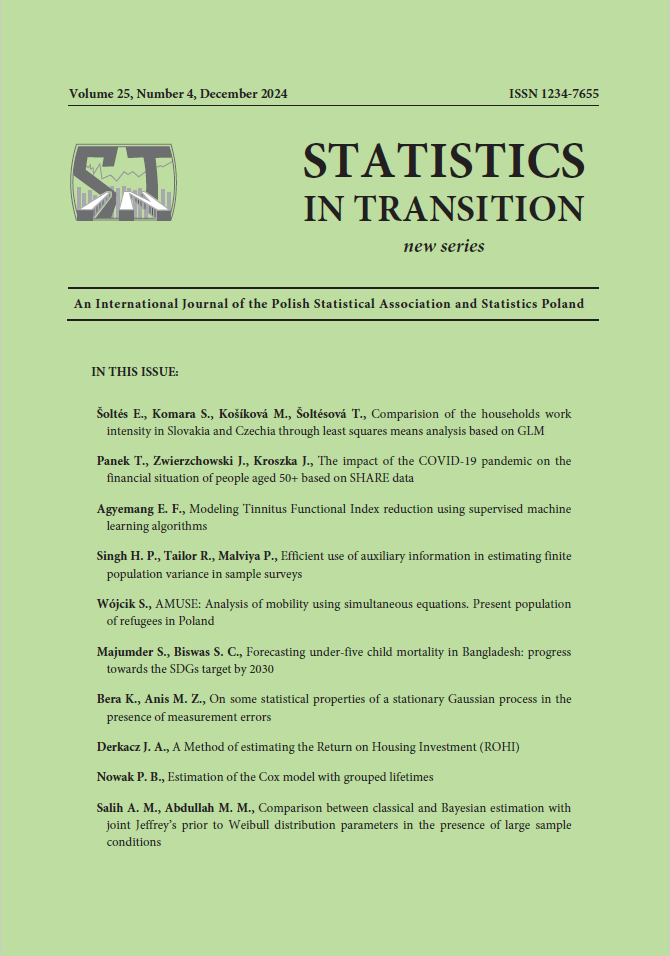ARTICLE
ABSTRACT
Due to the conflict in Ukraine, which escalated on 24th February 2022, and caused a large inflow o f Ukrainian c itizens t o P oland, a n eed t o i nvestigate t his phenomenon b y official statistics has arisen. When it comes to tracking the movement of refugees, statistical and administrative data sources fail due to the lack of timeliness or spatial granularity. Therefore, official statistics is reaching for big data sources which seem to be complementary to statistical and administrative data sources. In this paper, we deal with the synthetic Mobile Network Operator (MNO) daily data obtained from SIM cards issued to Ukrainian refugees by one of MNOs operating in Poland. We propose AMUSE, a workflow for data analysis, a model for the data deduplication and mobility estimation as well as a simple estimator of the present population. All these functions of AMUSE are based on the aggregated signaling data on time and territory.
KEYWORDS
mobility, Mobile Network Operator data, refugees, simultaneous equations, experimental statistics
REFERENCES
Ahas, R., Aasa, A., Yuan, Y., Raubal, M., Smoreda, Z., Liu, Y., Ziemlicki, C., Tiru, M. and Zook, M., (2015). Everyday space–time geographies: using mobile phone based sensor data to monitor urban activity in Harbin, Paris, and Tallinn. International Journal of Geographical Information Science, 29(11), pp. 2017–2039.
Alexander, L., Jiang, S., Murga, M. and González, M. C., (2015). Origin–destination trips by purpose and time of day inferred from mobile phone data. Transportation Research Part C: Emerging Technologies, 58, pp. 240–250.
Auerbach, F., (1913). Das gesetz der be volkerungskonzentration, Petermanns Geographische Mitteilungen, 59.
Baccelli, F., Błaszczyszyn, B., (2006). Tessellation in Wireless Communication Networks: Voronoi and Beyond it. Lorenz Center, Leiden University, 6-10 March 2006.
Badr, H., Du, H., Marshall, M., Dong, E., Squire, M. and Gardner, L., (2020). Association between mobility patterns and covid-19 transmission in the USA: a mathematical modelling study. The Lancet Infectious Diseases, 20(11).
Cleveland, R. B., Cleveland, W. S., McRae and J. E., Terpenning, I., (1990). STL: A Seasonal-Trend Decomposition Procedure Based on Loess. Journal of Official Statistics, 6, pp. 3–73.
Deville, P., Linard, C., Martin, S., Gilbert, M., Stevens, F. R., Gaughan, A. E., Blondel, V. D. and Tatem, A. J., (2014). Dynamic population mapping using mobile phone data. Proceedings of the National Academy of Sciences, 111(45), pp. 15888–15893.
Diao, M., Zhu, Y., Joseph Ferreira, J. and Ratti, C., (2016). Inferring individual daily activities from mobile phone traces: A Boston example. Environment and Planning B: Planning and Design, 43(5), pp. 920–940.
GUS, (2022). Health of refugees from Ukraine in Poland 2022, Household survey and behavioural insights research.
Lai, S., Erbach-Schoenberg, E., Pezzulo, C., Ruktanonchai, N., Sorichetta, A., Steele, J., Li, T., Dooley, C. and Tatem, A., (2019). Exploring the use of mobile phone data for national migration statistics. Palgrave Communications 5, 34.
Lanzieri, G., (2013). Population definitions at the 2010 censuses round in the countries of the UNECE region, in: 15th Meeting of the UNECE Group of Experts on Population and Housing Censuses, Geneva, Switzerland.
Lanzieri, G., (2019). Towards a single population concept for international purposes: definitions and statistical architecture, in: 16th Meeting of the Task Force on the Future EU Censuses of Population and Housing, Luxembourg.
Osborn, D., Chui, A., Smith, J. and Birchenhall, C., (1988). Seasonality and the order of integration for consumption. Oxford Bulletin of Economics and Statistics, 50(4), pp. 361–377.
Ricciato, F., Coluccia, A., (2021). On the estimation of spatial density from mobile network operator data. arXiv:2009.05410v3 [eess.SP].
Ricciato, F., Lanzieri and G., Wirthmann, A., (2020). Towards a methodological framework for estimating present population density from mobile network operator data. Pervasive and Mobile Computing, 68.
Ricciato, F., Widhalm, P., Craglia and M., Pantisano, F., (2016). Beyond the "singleoperator, CDR-only" paradigm: An interoperable framework for mobile phone network data analyses and population density estimation. Pervasive and Mobile Computing.
Särndal, C-E., Swensson and B., Wretman, J., (1992). Model Assisted Survey Sampling, New York: Springer.
Saidani, Y., Bohnensteffen and S., Hadam, S., (2022). Quality Of Mobile Network Data – Project Experience And Use Cases In Official Statistics.
Salgado, D., Sanguiao, L., Onacea, B., et al. (2021). An end-to-end statistical process with mobile network data for official statistics. EPJ Data Sci. 10, 20(2021).
Shams, M., Kausar, N., Agarwal, P.and Oros, G. I., (2022). Efficient iterative scheme for solving non-linear equations with engineering applications. Applied Mathematics in Science and Engineering, 30:1, pp. 708–735, doi: 10.1080/27690911.2022.2130914.
Shepp, L. Vardi, Y., (1982). Maximum likelihood reconstruction for emission tomography
IEEE Transactions on Medical Imaging.
Tennekes, M., Gootzen, Y., (2021). A Bayesian approach to location estimation of mobile devices from mobile network operator data. Journal of Spatial Information Science.
UNHCR, (2023). Displacement Patterns, Protection Risks and Needs of Refugees from Ukraine, Regional Protection Analysis #3, Trends analysis: Moldova, Poland, Romania, and Slovakia, November 2023.
UNHCR, (2024). Ukraine Situation: Regional Refugee Response Plan, January-December 2024.
Urząd Komunikacji Elektronicznej, (2022). Raport o stanie rynku telekomunikacyjnego w Polsce w 2022 r.
Van der Laan, J., de Jongey, E., (2019). Maximum likelihood reconstruction of population densities from mobile signalling data. In NetMob’19.
Wesołowski, A. Eagle, N., Noor, A. M., Snow, R. W. and Buckee, C. O., (2013). The impact of biases in mobile phone ownership on estimates of human mobility. Journal of the Royal Society, Interface, Vol. 10(81).
Zagheni, E., Ingmar,W., (2012). You are where you E-mail: Using E-mail Data to Estimate International Migration Rates, WebSci 2012.
Zhu, Z., Klein, A. B., Li, G.and Pang, S., (2023). Fixed-point iterative linear inverse solver with extended precision. Sci Rep, 13(1):5198. https://doi.org/10.1038/s41598-023-32338-5.
Zipf, G. K., (1949). Human behavior and the principle of least effort: Cambridge, Massachusetts: Addison-Wesley.
